Below you’re going to find my miniature painting tips on how to become a better painter. My goal is to keep them short and sweet. I’m not going to over explain anything because that would be counter-productive to what I’m aiming to do.
This article idea was sparked by a recent video that Games Workshop posted on color theory. If you haven’t seen it, definitely watch it. They seldom give you solid miniature painting tips. I know that sounds harsh but it’s true.
Now, this video marks a special moment for Games Workshop because it’s the first time they discuss theory. See, typically their videos (which are great) show you how to paint a model. The videos are short, easy to follow, and give you everything you need to recreate what they’re doing.
Therein also lays the problem.
You Be You
If you want to become a better miniature painter then my first tip is simple, don’t copy the work of others.
We all start somewhere with miniature painting and duplicating what we see on the box, or what someone else did is common.
I’m not saying don’t do this if you’re learning. However, at some point, if you want to grow as a painter, you have to forge your own path. You have to do something you came up with, not follow the work of others.
Every painter admires the work of other painters. We also look to others for inspiration and ideas. The miniature painting community is full of amazing work. Leave it at that though, admiration and inspiration.
Learn Theories & Concepts
This miniature painting tip is what makes that GW video so great. That being, learn painting theories and concepts.
You don’t have to be an art major to understand some basic painting theories and principles like color theory. Taking the time to understand the fundamentals of your hobby is crucial to expanding as a painter.
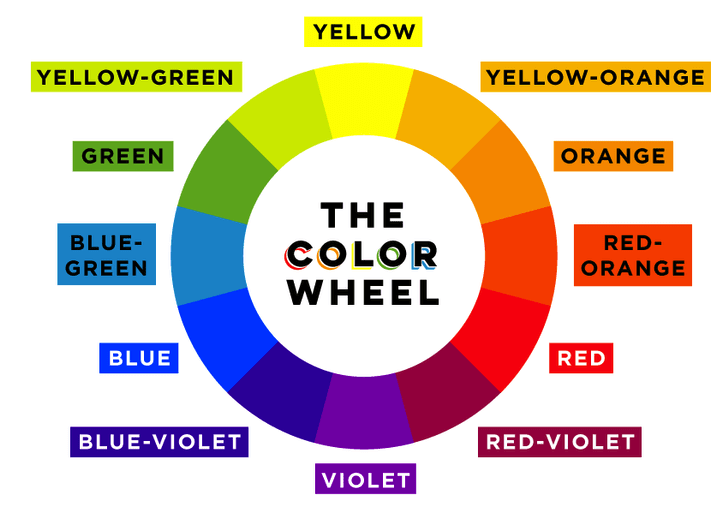
See, the color theory video doesn’t explicitly tell you what to do or how to do it, but it shows you a basic concept and how it’s applied to models. You are armed with information so that you can make your own decisions regarding color theory. This will take you so much further as a painter than being told to do X or Y.
Speaking of, Dave has a great set of articles he did on color theory over on Wargaming Tradecraft.
Which leads me to…
Always Learn Why
Bringing tip #1 and #2 together is this. Find painters you admire and ask them why they did what they did, not how. Try and get inside the mind of an artist and learn why they made the choices they did.
Why did they use those two colors there?
How come there’s little contrast on the model?
Why would you paint an entire model in shades of grey?
Understanding the thought process of painters will help you formulate your own process, concepts, and ideas. It’s going to get you thinking and making connections you hadn’t thought of before. It’s a bit intoxicating honestly.
Of all the miniature painting tips, this one is probably the most crucial.
Push Yourself All the Time
Push, push, push!
Nobody gets better at something by stagnating.
If you want to become a better miniature painter then you constantly need to be pushing yourself into uncharted territory. Try those techniques you feel are too difficult. Never settle for good enough. Get good at a technique and then move on to another.
If you need a hand, then check out the various tutorials I have here on things like using washes and glazing to get some nice subtle effects, or learning how to blend, maybe how to paint OSL, or push yourself to learn NMM (non metallic metal).
Do something that you’re not comfortable with. Just try something different.
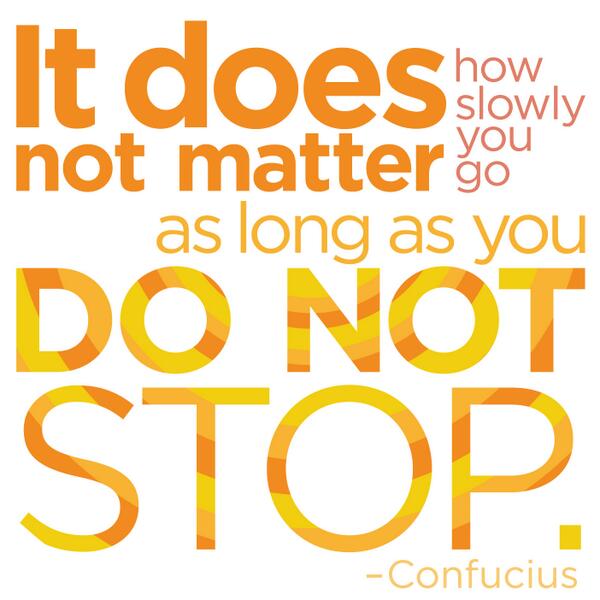
Recently I decided to paint some extremely rusty Stormcasts to do something different and to work on a new technique. I wanted to step outside my wheelhouse. I had so much fun doing something different that it lead to me creating a realistic rust tutorial.
Many of us painters plateau at some point. You get good, you like what you’re doing, and you are consistent. All great things. This is also when you dive into new waters and explore.
Leading me into…
Experience is Crucial
There’s no shortcut for experience.
You could watch the most amazingly produced video tutorial on a painting technique you’ve never tried and not even come close to matching it.
I think at this point in our lives we all understand the importance of experience, so I don’t think I need to sell this one much. Just remember that when you’re working on something and it’s not coming out quite the way you wanted.
Speaking of…
Failure is OK!
You’re going to fail and that’s OK. We learn from failure, so we accept it, we embrace it, and we do not shy from it.
My big advice in this area is to realize that and to work to completion. Don’t stop because the technique isn’t perfect, or the color choices aren’t 100% perfect. Push through it, finish it, and learn from it.
Let that model serve as a reminder of where you started, of the mistakes you made, and to show how far you’ve come, not as something to be ashamed of.
Now, I do have a guide on common painting mistakes and how to avoid them that will give you a bit of an edge here. Still, you’re going to have mishaps and accidents, it happens.
And here this rolls perfectly into the next…
Learn to Accept
Of all the miniature painting tips, this is the hardest thing to learn – acceptance.
Other than accepting your failures, you also have to learn to accept who you are as a painter. At some point you’re going to notice your style with painting emerge. I’ve talked about painting style before, so check that out if you’re unclear.
I think many of us tend to have a hard time accepting our style of painting, at least initially. I feel this is because we have a preconceived notion of what are painting will be like; often modeled after the painters we admire.
Instead of what you expect, you’re presented with something that’s uniquely you, and you need to learn to love that. Your style, your thoughts, your process, it’s all distinct and that’s what makes it amazing.
Embrace what you create, accept it, and you’ll grow for it.
Seek Constructive Criticism
This may be the easiest of my miniature painting tips. Almost everyone is on social media, so it’s really easy to share your work and get feedback.
Getting constructive criticism is extremely important as an artist. I fully believe that we paint for ourselves, and what we think of our own work is what matters.
Still, getting the eyes of other people on something you’re doing can often help because they may see something you didn’t. Plus, having more experienced painters see your work is a great way to get advice from them.
Having others check out your painting is also a great way to reaffirm things as well. Let’s face it, we all enjoy compliments.
Trust Your Gut
This ties into the last one a bit, but always trust your gut. This is just as true in painting as it is in life.
I have often used others, by showing my work, as a way to push this home.
For example, I might have done something that I wasn’t sure about, it didn’t feel right, but maybe it’s just me? So, I post it and get feedback. Without fail, people will spot the thing I was unsure of and I’ll get valuable feedback.
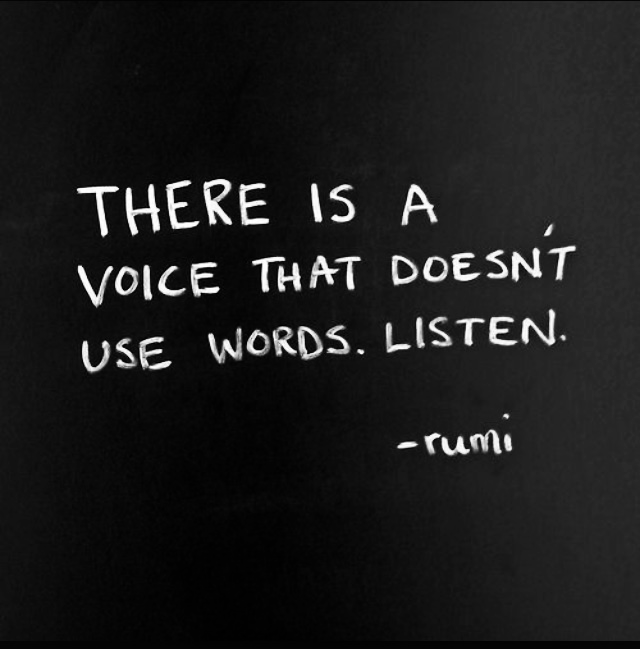
The point is, if you’re not comfortable with how something is going then step back and evaluate it. Give yourself some time with it. I’ve often found how I see something the next day is different than when I’m in the middle of it.
If it still doesn’t feel right later then trust yourself and find another solution. It’s better to spend more time on something than you planned and be happy with it than rush through and not like it.
Don’t Overthink It
This one plays off of trusting your gut, and may be the biggest thing I struggled with as a painter.
I’m a programmer by trade. I make my living typing code and thinking through everything logically. Painting, or art in general, may be the furthest thing in the world from programming. Art is at the whim of artist and intended to convey a feeling, mood, or have some other desired effect by the artist.
I used to try to approach miniature painting like programming. I would look at the models as a problem that needed solving and all the solutions would be predetermined responses, an algorithm.
Now, it’s not a bad idea, that type of mindset, if you’re trying to methodically paint an army and you see it as a process, not something you want to be doing. However, I wanted to enjoy painting and the rigid mindset was having the opposite effect.
I started over thinking everything, trying to find the precise way light would reflect of this particular surface in these particular conditions…it was overwhelming.
That’s not to say you shouldn’t have references and an idea how things should look, however, don’t let it consume you. Trying to paint everything as realistic as possible will drive you mad, and no matter what you do, it will never look right to you.
There is a common phrase with miniature painting – the rule of cool. This translates to just doing things that look cool regardless of whether or not they’re accurate. Maybe the light wouldn’t bounce off a surface in that way, but it looks cool, so who cares?
Bob Ross is a huge inspiration to me, which I’ve talked about in length before. Not because his art was amazing, which I think it is, but because of his attitude and mentality with painting. With Bob it’s never about getting everything perfect; it’s about enjoying what you’re doing and being free with it.
I even did a guest article on Tangible Day about what Bob Ross taught me about miniature painting.
Anyway, just let your mind drift off a bit and let your brush guide you, not your consciousness.
There’s Always Tomorrow
I’ve mentioned this before, but I’m a very patient person. I’m not impulsive and I’m not quick to anger. However, when it comes to painting I can get very aggravated, anxious, and impatient. While I enjoy miniature painting, I often reach a tipping point where I just want it done.
In those moments I try to step away. If I paint through those impatient moments then it shows on the model. It could be that it’s just sloppy, a poor choice in color because I used what was already on my palette, or simply letting my standards slip.
Sometimes I just set aside the model for the next day and that’s OK. It’s better to approach a model in the right mind-set than to do something just because you have the time to do it.
Take Pride in Your Art
At the end of the day, you want to take pride in your art. Even if what you just painted wasn’t your best, you should be proud of yourself for finishing something, and for learning from those mistakes you made in the process.

It’s easy to give up, to not push yourself to new heights, but it takes strength and determination to try to improve your painting, to fail, and to keep going.
So, always appreciate what you’ve done and never hang your head in shame.
I’ve painted some stuff that I’m not 100% happy with, but I can always find something on the model that I’m really happy with, so it’s never a complete failure, and I can take pride in that at least.
Never Apologize!
I was looking at buttons the other day and saw this on a button, so I take no credit for it.
Never apologize for your art.
Anonymous
On this entire list of miniature painting tips, this is the one thing I struggle the most with. We, as artists, are naturally defensive about what we create. So, by issuing an apology ahead of time we are putting it out there that what we’ve done is not perfect and there’s no need to point that out. We are shielding ourselves from criticism.
I try like hell not to do this, and I’ve gotten better at it, but it’s a struggle we all deal with. However, by not apologizing we are accepting what we’ve created. We leave ourselves open to praise and criticism alike and can in turn grow as artists.
You don’t have to love everything you do, and it’s fine to see the flaws in it, but don’t apologize for it.
Paint Something Different
This one was mentioned by Robert in the comments and I couldn’t agree more.
If you play a large scale game like Warhammer 40K, Age of Sigmar, etc., then you’re going to be painting a lot of the same stuff repeatedly. It doesn’t exactly inspire motivation to try something new with techniques.
Even if you play a smaller scale game with more diversity in the miniatures, you’re painting in a particular setting and can still get complacent with what you’re accomplishing painting-wise.
By branching out on what you’re painting you almost clear your mind a bit and see things differently. Painting a model car is not the same as painting a Space Marine for 40K. Painting a comic book character isn’t the same as a Barbarian. The techniques will change, the approach will change; it’s just different and that’s great for painters. We need diversity.
One of the biggest things I did to improve my painting was starting to play Warhammer Underworlds. The warbands are small 3-5 models on average, and each warband is very unique.
Prior to that I was purely a Warhammer 40K player, with some Blood Bowl on the side. Jumping into a fantasy setting with different races, and a different setting entirely, let me feel confident to try out some new stuff – to push myself more.
I also painted my first bust. It was a lot of fun to paint and very different than painting miniatures. There was a lot I learned painting the bust that I might not have otherwise learned if I stuck to the usual stuff.
So, try something new!
Step Away from Social Media
I talk about this subject in my common painting mistakes article – comparing yourself to others. So, I won’t cover that too deep here.
However, relating to that is to just take a break from social media. The problem with social media is that many of us tie our value as artists to it. You post something you put a lot of work into and you only get a few likes and no comments. That can be extremely disheartening.
On the other hand, you could get a lot of likes, everyone comments, and feel really good about yourself.
I think we all have a love/hate relationship with social media. It’s great when it’s great and sucks when it’s not.
Anyway, step back and focus on your miniature painting. Stop scrolling Instagram and seeing amazing pieces by other painters that demotivate you. Stop seeking those likes on Facebook or Twitter. You don’t need others to validate you.
Think of all that time you spend chasing likes and validation. That time could be spent improving your painting, learning new techniques, or reading or watching tutorials to better yourself.
I admit, it’s not easy to set aside social media, it’s become a part of our lives, but you’ll be a better painter for it.
Pick an Element to Stand Out
Another of the easier miniature painting tips!
When I’m trying to improve my painting, and I’m learning a new technique, I like to choose an element of the model to work on. Trying to paint an entire miniature in a new way can be an exercise in frustration.
However, if you choose an element or two on that miniature to try something with, then it’s far easier. Paint the rest of the model in your standard way, but really push that area you’ve chosen.
Take this Skull Champion I painted. I painted this to a tabletop standard but spent a little time making his power sword stand out. It gave me the chance to experiment with something.
Other than it making learning easier, choosing an element can really make a miniature stand out as well. Find a great focal point, be it a weapon, the face, etc., and really make it stand out and draw the eye.
Our eyes naturally gravitate towards certain part of a model, so figure out what that is and spend some time on it.
Also, this is great for things you’re painting more to a standard quality to draw the eye from that. If the eye is drawn to a well painted focal point, then it pulls the gaze away from areas that may not be as well done.
Bonus Miniature Painting Tips
I asked some of the painters I really admire the work of to tell me what their advice would be on becoming a better painter. Here’s what they said.
Painting miniatures is a great way to find relaxation in our stressful lives. It’s an amazing hobby with endless improvement possibilities for you as a hobbyist. Cherish it and try to avoid painting because you must and only because you want to. You get the most out of a painting-session if you paint on your own terms and paint the models you find cool or interesting. Best way to get better is to be curious and brave and it’s perfectly fine to fail. The best painters have failed more times than the beginners have tried.
– Johan Hoflin @Hoflin
This one is from Mengel Miniatures. You may have seen a lot of his work on the Warhammer Community site.
Always learn the proper way to utilize a technique or method before learning the shortcut. This way you’ll understand why it works the way it does and have a better grasp on it.
-Mengel Miniatures
How I Improved My Miniature Painting
Now, you might be looking for something more actionable. I stand by the above tips because I really feel like painting is more mental than physical.
Still, there’s some specific things I did that really improved my painting ability too.
I Started Using a Wet Palette
Like everyone, I started painting using a dry palette. It worked, it did its job, and I had no complaints.
After constantly hearing about wet palettes from painters I admired, I decided it was time to see what it was all about.
This was the biggest thing I’ve done that has improved my painting.
Thinning Paints
A wet palette taught me about properly thinning paints. You can thin paints on a dry palette of course, but the problem is it dries up on you, and always before you’re done with the paint.
This was always a frustration to me. Thinning my paint had become a chore because I was constantly needing to add more paint, and then more water, and repeating the process endlessly.
On a wet palette the thinned out paint remains that way for hours, sometimes days. There’s no messing around with constantly needing to refresh the paint.
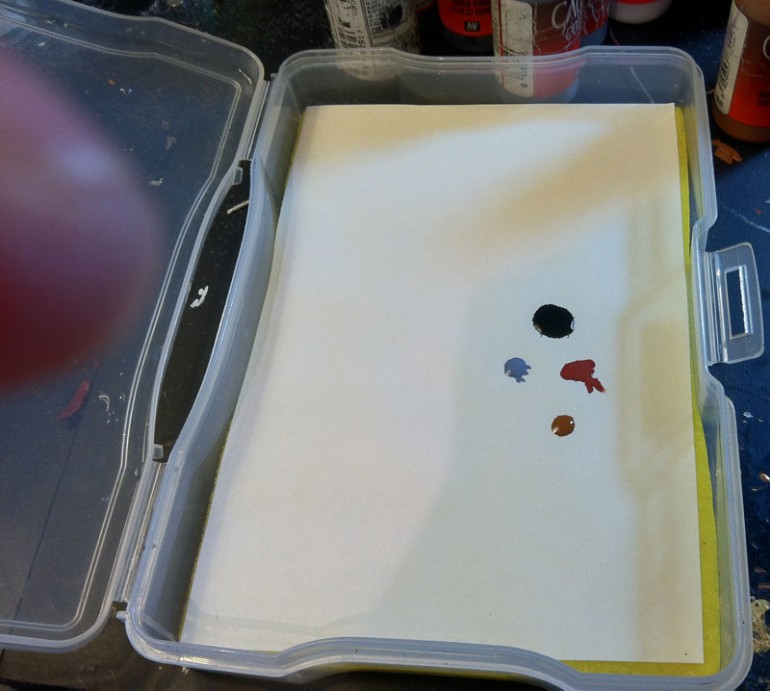
See how wet that paint looks? It stays that way for the entirety of my painting sessions.
If you’d like to learn how to make your own wet palette, then check out that link.
Anyway, all this of course leads to nice smooth coats of paint on the miniature. No dried up chunks of paint getting dried into the finish. There’s no brush strokes on the model. No built up layers of paint obscuring details.
It was from that point, once I was comfortable with the wet palette, that I began gaining an interest in learning to blend. This wonderful tool lead me to a decision to try a new technique that would change it all.
Learning to Blend Changed Everything
The thing you begin to realize once you start learning to blend miniatures is that the technique has so many uses and applications.
It doesn’t matter what style of blending you prefer, the end result is ultimately the same too.
I had started to learn how to do blending as a way of creating smooth transitions for shading. I wasn’t pushing contrasting highlights a lot, just trying to get some smooth shading really.
This Herald of Khorne, specifically the Juggernaut, was where this process began.
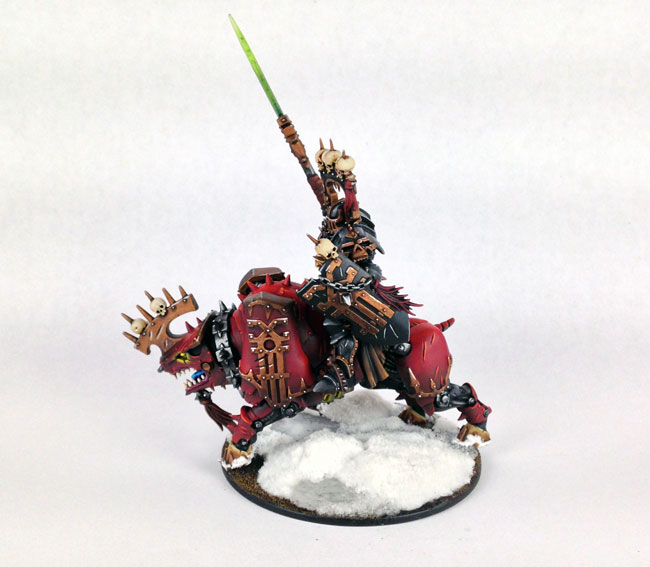
You can see some blending shading on the mount; that’s what I was working on.
That got me thinking about creating a striking weapon that contrasted with the Juggernaut. I set about trying to figure out how to blend a power weapon and got this result.
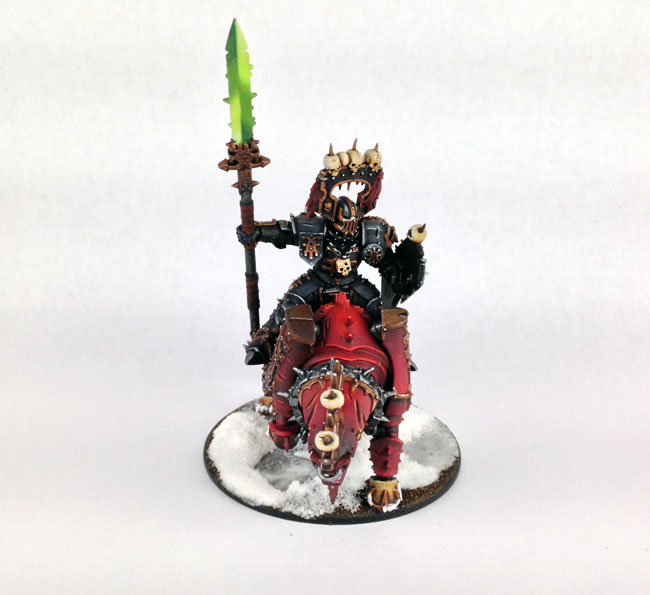
To say I was pleased with that power weapon would be to put it mildly. This miniature remains a favorite of mine because of what I learned in painting it.
After my success with that weapon, I then went on to create a power sword painting tutorial.
The Evolution to NMM
After a few years of learning how to blend and applying the technique to various miniatures, I started thinking about NMM (non metallic metal).
I had always been impressed by painters who made NMM seem flawlessly easy. A well done NMM gives so much interest to a miniature that, in my opinion, a typical metallic paint does not.
For years I fooled myself into thinking that while NMM could look great, that it was ultimately just a painter flaunting their skills. It wasn’t necessary and normal metallics, or even TMM (true metallic metal), was generally the better choice.
One day I tried it.
Painting NMM
I had a miniature I bought years ago that I determined would be my NMM experiment.
Here’s that model.
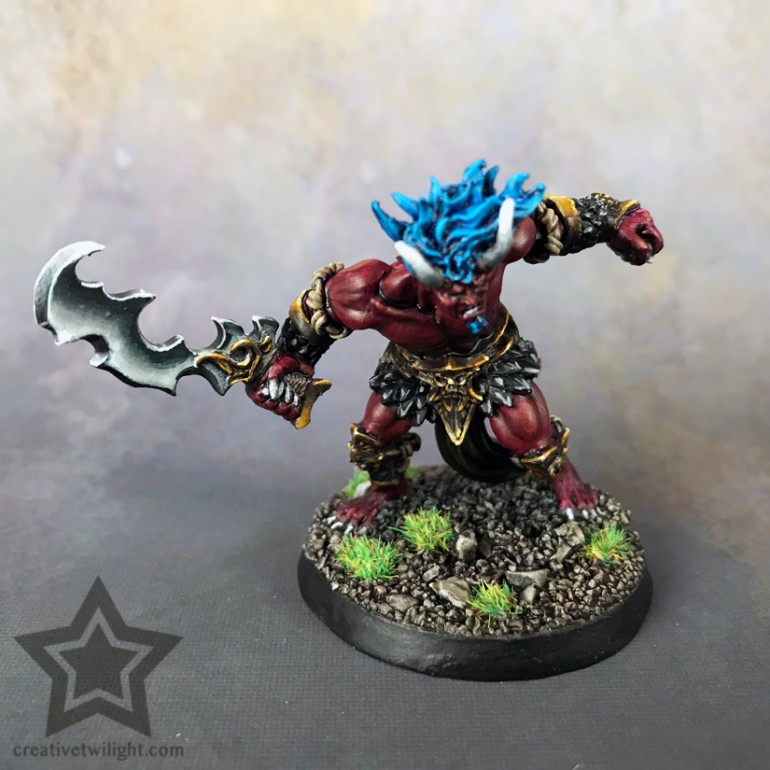
I’m not particularly proud of that sword, but it was my first attempt and perfection could not be expected.
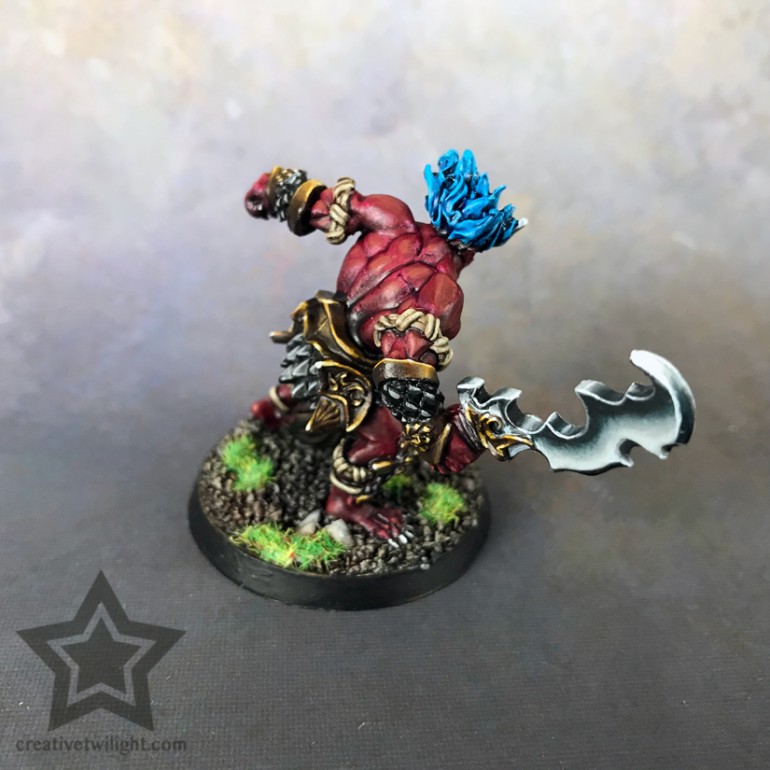
I was, however, pretty happy with my attempts at creating a bronze NMM look to the armor.
What I had learned in the experiment was that by using NMM I could get exactly the look I was after. I had full control over shading, highlighting, and tone in a way that I never felt with normal metallics.
I then realized that’s why so many painters use NMM on their miniatures – precise control.
Here’s a more recent example showing my NMM steel and gold.

Those shadows, midtones, and highlights are all exactly where I placed them and that’s what you see – what I want you to see. There’s no light bouncing off a metallic surface, changing how this looks at different angles. That NMM is exactly how I painted it.
Also of note is how rough that NMM looks. It’s not perfectly blended out and has a bit of a cartoony look to it. That’s a conscious choice of mine regarding blending; to just have fun. and not get bogged down
More on that below.
I do also have a tutorial on the quick and dirty way to paint NMM if you’re interested.
Blend, Blend, Blend
By learning how to blend I learned how to create smooth surfaces. I learned how to blend skin so it looked good; previously a very weak point of mine.
Blending showed me how to create a striking power weapon and create strong contrast.
I came to realize that NMM is just an approach to blending, a style, and something to embrace.
Once I learned how to blend I had opened the door to so many possibilities.
Finally Bought Good Miniature Brushes
While I was learning how to blend miniatures I was using Citadel brushes. I found them serviceable and better than I had expected.
Still, I was having some issues with blending that I couldn’t help but feel a better brush would help alleviate.
I did some research on miniature brushes and settled on the Raphael 8404 series. I ordered my brushes online and picked up the size 2, 1, and 0.
They were amazing!
You ever do something new and ask yourself why you didn’t do it sooner? Yeah, that was exactly how I felt painting with the Raphael brushes.
The brushes are expensive, I won’t lie, so that was often my hesitation – cost. I felt I had learned to take better care of my brushes. Also, that I wasn’t as rough on them in general. So, the expense could be justified.
It Just Makes Everything Easier
I always say that a good brush doesn’t make you a better painter but it sure does make it easier.
The skill of a painter isn’t in the paint brush. However, with a good brush you can accomplish things so much easier. When things are easier to achieve it motivates you.
Fighting a paint brush to learn a technique is frustrating and will cause you to lose interest quick. By losing interest you aren’t going to feel like pushing your skill.
With the brushes I’m using, I feel like they are a part of me and not a tool to be manipulated into doing something. The paint goes on smoothly. The brush tip stays sharp and allows for easy highlighting and straight lines for freehand. Bristles are soft and allow for easy blending for transitions.
No doubt I could go on and on about this subject but I’ll leave it there.
I still use the Raphael 8404 brushes and I still love them. I’ve also got some Winsor & Newton Series 7 brushes that I’m testing to compare to the Raphael brushes.
It’s too early to say where I fall on that experiment yet, but the Winsor & Newton Series 7 brushes are also fantastic.
I’ve also written an article that talks about miniature paint brushes in a bit more depth.
I Made the Choice to Get Better at Miniature Painting
I believe that so much of learning to get better at anything in life is based on the choice you make to do it. You may improve at something regardless of choosing to, but you really aren’t going to get better at it either.
Yeah, sounds like I’m splitting hairs, and I am.
I’m no psychologist, but for me I had to decide I wanted to get better before I could. By making that choice I started pursuing new techniques, new tools, and learning ways to become a better painter and improve my skill.
It’s not that choosing to get better makes you better, but it sets your mind to a goal. Having a goal, an ambition, drives you and fuels your desire to learn. It’s that simple.
Experimenting and Learning the Hard Way
This is something I’m still doing, and that’s experimenting and just trying different things to see what happens.
I can read endlessly about a technique or a theory. It’s just a concept, an idea, until I put brush to miniature.
Hell. A lot of times I just see what I can do before I read about the proper way to do something. The results are very often mixed, but what it does do is teach me a lesson the hard way, for better or worse.
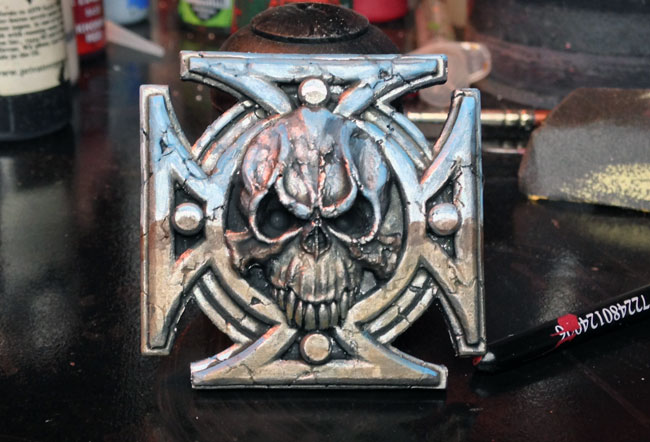
Take the above piece. I wanted to try my hand at painting a TMM (true metallic metal) chrome. I was pretty pleased with the result.
Once I’ve tried something I at least have a basic understanding of whatever it was I was trying to accomplish. From there, if I go on to read about it from other painters, I at least know what they’re talking about. That’s invaluable to me and how I learn.
I feel that most of us learn better using a hands-on approach.
I’m never afraid to try something and fail either. A lesson is learned in that failure. That lesson is one that I won’t forget either because I experienced it; I didn’t read about it.
I Just Have Fun With Miniature Painting
The final thing I wanted to talk about is just having fun with miniature painting.
As some of you know, I’m a programmer. It’s how I make a living. While I do also feel like I’m a creating person as well, often that logical part of my brain will fight me.
I cannot tell you how many times I have spent hours upon hours making a decision regarding a choice in painting. My approach is often like that of a program I’m creating in that I want to do it correctly from the start to save time on having to adjust or recreate earlier elements.
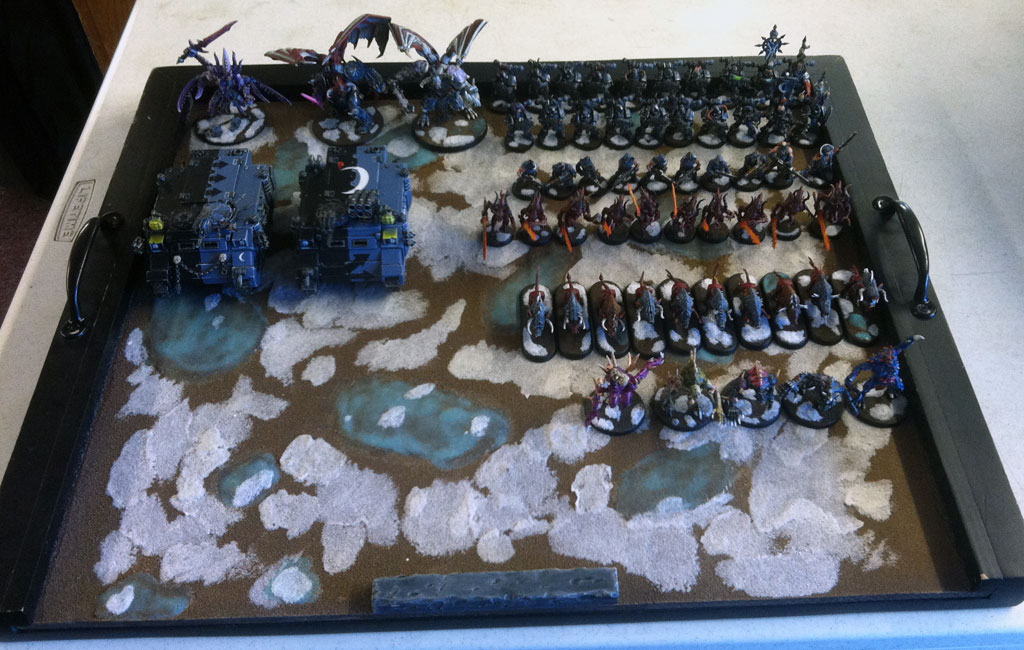
I know that army shot above isn’t great but it doesn’t matter. Having a planned and methodical approach is great for getting an army fully painted. All things are base coated in this color, highlighted with that color, based this way, etc.
While that methodical view has its uses, it can also be so debilitating and crippling to creativity. Not to mention just boring.
Creativity is an expression of yourself. It’s a feeling you convey with your art. Logic has a role in there but it shouldn’t be a constraint either.
That’s what I tell myself when I’m sitting there staring at a miniature trying to break every element down into something logical to create a plan of action.
I try to turn off the left brain for a while and focus on right brain.
Let it Go, Let it Go
When I finally settle into that creative side of myself I just have fun with painting.
I stop caring if what I’m painting is perfect. If what I’m doing gives me enjoyment, then that’s all I care about.
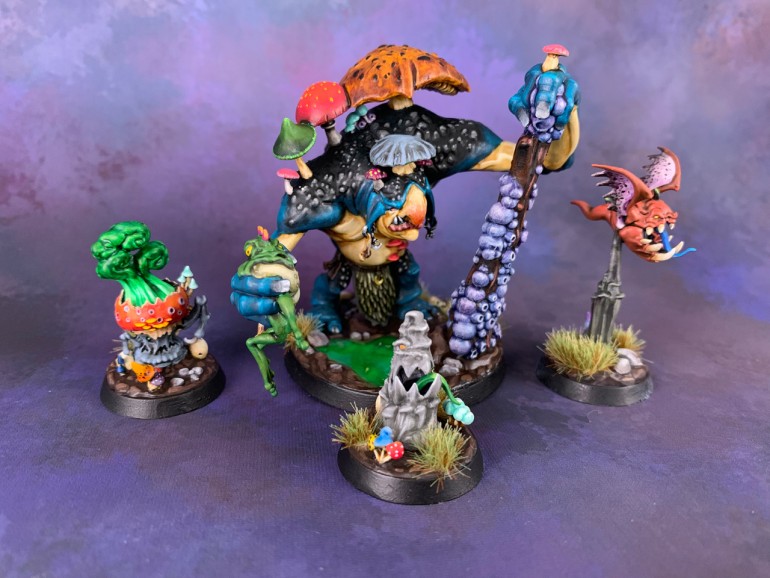
This Mollog’s Mob warband I painted for Warhammer Underworlds was a project where I just wanted to have fun with colors. I felt like trying stuff I had never done and using colors I normally didn’t. I just had fun with it.
Getting bogged down in analysis and the correct way of doing things is a hindrance I’m happy to shed.
This has led me to forgo doing things in painting that I find annoying. If what I’m doing isn’t fun, then why a I doing it? I’m painting for my own enjoyment, my own sense of satisfaction, and I have nobody else to impress.
I learned to stop doing things that are right for the sake of doing things that are fun.
Video Format
If you prefer video format, then I’ve done a video that covers most of the miniature painting tips above. It’s a bit different so worth a watch.
Conclusion
Hopefully you found this little list of miniature painting tips useful. I’ve been doing a lot of research lately for something unrelated to this, a project of sorts, and this is the type of stuff I’ve enjoyed reading in that process – short, insightful advice that doesn’t overdo it. I like being taught how to think about something, not what to think.
I also think that learning to get better at something, anything, is 90% self-confidence and 10% skill. If you don’t believe in yourself then you won’t improve. However, a little advice, guidance, and a pat on the back can go a long way towards a goal.
If you’re looking for more help with miniature painting, then check out the guide I created. It covers pretty much everything.
Now, while I feel that it’s not the tools that make the painter, I do have an article that covers the essential painting supplies everyone needs that you may find interesting. There’s the basics you expect, but also a few gems you may never have thought about.
If you have your own advice to share then I’d love to hear it in the comments.
- Creative Twilight’s Future and My Thoughts (Feedback Welcomed!) - December 4, 2021
- My Top Gift Ideas for Miniature Painters & Hobbyists + Gifts to Avoid - December 2, 2021
- The Year That Was 2020 and Where I’ve Been - January 17, 2021

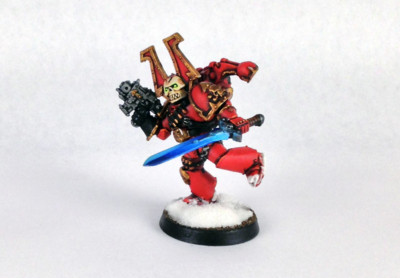



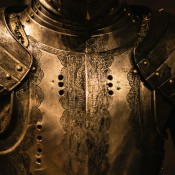

On “Acceptance”, it’s also important to be able to accept when you’ve gotten as far as possible with something, and you’re not going to be able to gain anything in terms of either quality or experience, and it’s time to just let it be done, take what you learned so far, and move on to the next project. A new start like that can really help solidify what you’ve got so far and move on to the next step in your progression.
Exactly.
“Don’t let perfect be the enemy of good”. The main reason I don’t get to game much is because I won’t play with unpainted miniatures and I’m always tinkering with the ones on my desk, trying to make them look a little better.
I’m just now (after 35 years doing this) getting to a place where I can say “this looks great for the tabletop” and if I want to touch them up some other time, fine – but get them ready to play is the first step.
Absolutely.
Learning to like your own work isn’t easy. We always see all the flaws that nobody else does. It’s a reason I post the stuff I do here or on social media. It’s not about getting praise so much as validation.
I was somewhat faster to hit that point, but it still took me maybe 10-12 years.
I think it took me a solid 10 years to understand that. The lesson? We’re all slow damn learners, lol.
Of all the things above, my breakthrough came when I made myself push on through. I used to get midway through a paint job, hate what I saw, and toss it into the Simple Green.
When I finally forced myself to keep working instead, I discovered something wonderful. It’s sort of like remodeling your house – midway through the job, it looks like a disaster. You can’t imagine it will ever look good. But if you keep at it, the end result is a reflection of the added effort.
I feel most of us can share this sentiment. Granted, I don’t dump it in Simple Green, but I also question choices mid-way through and stall out. I always slow down and lose motivation, and I have to force myself at times to finish something.
That feeling of finishing a model though, it’s worth it every time.
I have definitely had some projects that looked like absolute garbage until I hit a certain point, and then it just pulled the whole thing together. I’ve definitely been better about pushing through since I recognized that.
I would add one point to this list and that’s “Know your goal”: When you’re painting a mini, are you painting it to be a display piece, a centrepiece for an army or unit, or is it a smaller part of the whole? A lot of people worry about not having painted all the bits and bobs and little details, and declare themselves bad painters. But often, particularly with squads of models, it isn’t the individual details but the cohesive look of the unit that’s important.
For example, my Space Wolves are a company of heroes, each with his own saga and legacy of war. So they all have little details on them signifying acts of valour or particularly memorable battles. I like to have each and every detail painted to tell the story of that one guy.
My Iron Warriors on the other hand are the pawns of the gods, the meat sent into the grinder for a higher purpose. I don’t worry so much about each model, rather I worry about how they’re going to look clustered up against the battlements of my enemy’s fortifications. One termagaunt will never be impressive, but a swarm of 40 of them will blow you away.
That’s a great point and to add further to it, quality. I paint my HQs and stuff to a higher standard all around. I’ll do blending, OSL, etc., on an HQ, but rank and file gets basic layers with a wash and highlights.
So what about those directly below hq surly they deserve a little more glory that infantry
I usually paint the basics to a normal standard but I’ll add in little flourishes like OSL on weapons, lenses, etc. Lets them stand out from grunts without spending too much time on them.
Good advice for painting–and for life.
Thanks, and painting is life ;)
Wonderful advice that I somehow missed first time around.
Thanks. It’s hard to catch everything as it comes up on every site too.
might I add a suggestion, for branching out and growing, is to try other models, not just miniatures, sometimes the techniques and process can be used and perfected on those as well, I prefer comic book characters because of the brighter colors, and learning to control lines where opposing colors meet up. Using thin coats I can adjust the line to a more “natural” feel or if I make a mistake
I also learned a few tricks painting cars and trucks for working with some of the clear paints on windows or mirrors and how to blend out the edge of applied decal on something a bit larger.
That’s a great point and something I totally agree with. I haven’t branched out quite that much, however, the difference in painting stuff that wasn’t Warhammer 40K has been a huge boost to my painting ability. I think simply put that variation in general is the key, so yeah, I’ll totally add that one in. Thanks!
I have come into the hobby from that background looking for ways to step my painting game up and try new things this hobby has certainly pushed me out of my comfort zone and I want to take my painting from the videos of Duncan Rhodes to the next level of someone like Dana howel and squidmar
Having ambitions and goals is key to progress. Otherwise it’s so easy to stagnate.
Bob is my spirit animal. These are all great tips. The best one is to have fun, just have fun and don’t make it too stressful with chasing growth. Learning and improvement are great, but don’t let them kill the joy of painting little minis.
Thanks.
Exactly. If you aren’t having fun doing it then why bother?
I think we’ve all been there and then you reach that realization that hey I started this for fun. Why am i making it stressful? lol
You’re absolutely right. I find there’s 3 stages to painting.
Stage 1) You’re learning, having fun, and think everything you’re painting looks great.
Stage 2) You question everything you’re doing because you think everyone paints better than you.
Stage 3) You realize you’re stressing too much about perfection and just decide to have fun and enjoy painting no matter what.
Unfortunately so many never reach that 3rd stage.
That’s it exactly! Ironically the last stage is where you start to grow the most!
Agreed!